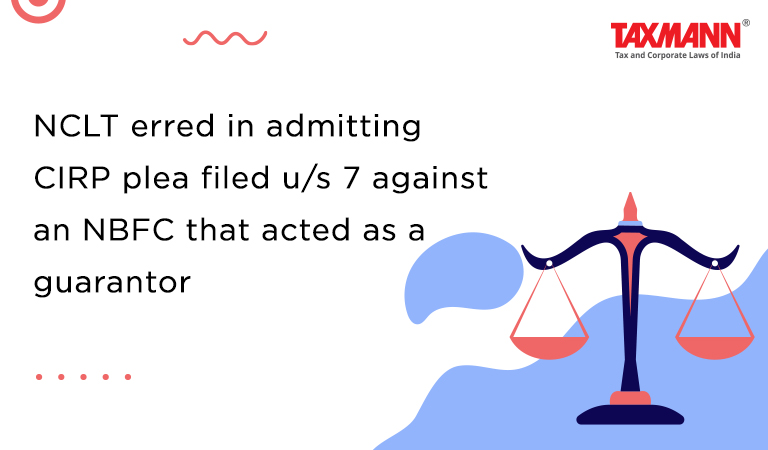NCLT erred in admitting CIRP plea filed u/s 7 against an NBFC that acted as a guarantor
- Blog|News|Insolvency and Bankruptcy Code|
- 3 Min Read
- By Taxmann
- |
- Last Updated on 20 March, 2023

Case Details: Nirmal Kumar Agarwal v. State Bank of India - [2023] 147 taxmann.com 495 (NCLAT-New Delhi)
Judiciary and Counsel Details
-
- Rakesh Kumar Jain, Judicial Member & Kanthi Narahari, Technical Member
- Anup Kumar, Ms Shruti Singh & Ms Neha Jaiswal, Advs. for the Appellant.
- Vaijayant Paliwal & Nikhil Mathur, Adv. for the Respondent.
Facts of the Case
In the instant case, an appeal was filed before the Hon’ble National Company Law Appellate Tribunal (NCLAT) against the decision of the National Company Law Tribunal (NCLT).
The NCLT had admitted an application under section 7 of the Insolvency and Bankruptcy Code,2016 file by the State Bank of India (Financial Creditor) against the Sungrowth Share and Stocks Limited (Corporate Guarantor) on account of a default committed by the Corporate Debtor (M/s Adhunik Alloys & Power Limited) in paying the financial debt of Rs. 63,04,53,226.
M/s Adhunik Alloys & Power Limited was already in Corporate Insolvency Resolution Process (CIRP) vide order dated 23-8-2017 of the Adjudicating Authority, whose resolution plan was approved by the Adjudicating Authority on 7-12-2018.
State Bank of India (Respondent herein) had submitted its claim of Rs. 324.73 Crores, which was considered in the plan but meanwhile the SBI filed an application under section 7 of the Code against Sungrowth Share and Stocks Limited stood as a Guarantor for recovery of the outstanding balance of the Corporate Debtor. The NCLT admitted the same.
In the appeal, the appellant submitted that the application filed under section 7 of the Code was not maintainable and the Adjudicating Authority had no jurisdiction to initiate the proceedings because Sungrowth was a non-banking financial institution (NBFC) and was registered as such by the Reserve Bank of India (RBI) vide certificate of registration no. B.05.03435.The certificate was issued on 28-3-2001 and was granted to carry on the business of a non-banking financial institution without accepting public deposits subject to the conditions given in the said registration certificate.
Under the provisions of the IBC, 2016 no CIRP can be initiated against a financial service provider.
Section 3(8) defines corporate debtor, “which means a corporate person.” Meaning thereby in order to become a corporate debtor entity has to be a corporate person but a financial service provider is not a corporate person.
The financial service provider is defined in section 3(17) which says that any person to whom registration is granted by a financial sector regulator. Section 3(18) defines the financial sector regulator which includes the Reserve Bank of India.
The respondent argued that the registration of the Appellant dated 28-3-2001 was cancelled vide order dated 9-7-2018/11-7-2018. It is further submitted that even if the application under section 7 of the code was filed on 8-6-2018 and at that time the certificate of registration was in operation but it came to end during the pendency of the proceedings on 9-7-2018/11-7-2018, therefore, the application filed under section 7 of the Code by the Respondent (State Bank of India) was in accordance with the law.
NCLAT Held
The NCLAT held that Sungrowth having the registration in terms of section 3(17) as a financial service provider by the financial service regulator in terms of section 3(18) by RBI as on 28-3-2001 which continued up to 9-7-2018/11-7-2018 cannot, in any case, be called a banking institution.
It has to be called a non-banking financial institution and in such a scenario the application filed under section 7 of the Code on 8-6-2018 was not maintainable on that date and therefore, the Adjudicating Authority had no jurisdiction to invoke its power for the purpose of initiation of CIRP proceedings.
List of Cases Reviewed
-
- Dr Jagmittar Sain Bhagat v. Dir Health Services [2013] 10 SCC 136
- Kiran Singh v. Chaman Paswan AIR 1954 SC 340 (para 12) followed.
- Order of NCLT (Kol.) dated 4-9-2019 (para 13) affirmed.
List of Cases Referred to
-
- Randhiraj Thakur v. Jindal Saxena Financial Services (P.) Ltd. [2018] 94 taxmann.com 340 (NCLAT – New Delhi) (para 5)
- Housing Development Finance Corporation Ltd. v. RHC Holding (P.) Ltd. [2019] 107 taxmann.com 200/155 SCL 4 (NCLAT – New Delhi) (para 5)
- Dr Jagmittar Sain Bhagat v. Dir Health Services [2013] 10 SCC 136 (para 12)
- Kiran Singh v. Chaman Paswan AIR 1954 SC 340 (para 12).
Disclaimer: The content/information published on the website is only for general information of the user and shall not be construed as legal advice. While the Taxmann has exercised reasonable efforts to ensure the veracity of information/content published, Taxmann shall be under no liability in any manner whatsoever for incorrect information, if any.

Taxmann Publications has a dedicated in-house Research & Editorial Team. This team consists of a team of Chartered Accountants, Company Secretaries, and Lawyers. This team works under the guidance and supervision of editor-in-chief Mr Rakesh Bhargava.
The Research and Editorial Team is responsible for developing reliable and accurate content for the readers. The team follows the six-sigma approach to achieve the benchmark of zero error in its publications and research platforms. The team ensures that the following publication guidelines are thoroughly followed while developing the content:
- The statutory material is obtained only from the authorized and reliable sources
- All the latest developments in the judicial and legislative fields are covered
- Prepare the analytical write-ups on current, controversial, and important issues to help the readers to understand the concept and its implications
- Every content published by Taxmann is complete, accurate and lucid
- All evidence-based statements are supported with proper reference to Section, Circular No., Notification No. or citations
- The golden rules of grammar, style and consistency are thoroughly followed
- Font and size that’s easy to read and remain consistent across all imprint and digital publications are applied





